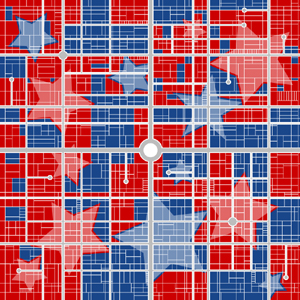With the media spotlight shining on police militarization, most Americans know something about the federal 1033 transfer program that enables police departments to get military equipment like armored vehicles, high power weapons, grenade launchers, and even bayonets. But most Americans don’t realize that local law enforcement agencies can also acquire spy gear from the feds.
The NSA transfers electronic gadgets to a variety of agencies including local law enforcement, and it is as simple as catalog shopping.
This is yet another example of the tangled web of cooperation between state and local law enforcement, and the feds – a phenomenon quickly devolving America into one massive interconnected surveillance state.
These transfer programs have largely gone unnoticed. However, the most recent NSA tech catalog was recently released and sheds some light on the program.
The catalog contains the following mission statement.
“In the context of federal laboratories, technology transfer is the sharing of information, intellectual property (IP), expertise, and technology between the laboratories and non-federal entities (i.e., private industry, state and local governments, universities, and non-profit organizations).”
Some of this technology is specifically marketed to law enforcement:
Here are just two examples of the technology your local cops can get their hands on.
Passing a Cryptographic Key and Allowing Third-Party Access to the Key view the patent here.
Simply put, this technology allows law enforcement access to encrypted information by providing them a way in. In words of the patent maker,
“Essentially, key escrow is a cryptographic method that allows a third-party (e.g., a law enforcement) access to the key used by a first user and a second user when the third-party is authorized to do so (e.g., when criminal activity is suspected and a search warrant is obtained).”
In essence, these keys provide a backdoor into your computer.
To better understand key exchanges, you can view this short three minute video on asymmetrical encryption.
RENOIR View patent here.
This is an application that allows users to easily visualized large data sets through graphics. This doesn’t sound too ominous until you relaize that search engines, telecommunications and data mining industries are also targeted. The Schneier Blog calls it the “NSA telephone network visualization tool.”
The NSA describes the functions of the Renoir application.
It provides user control of node icons, node color, node labeling, link colors, link styles, link labeling, and a host of other preferences. Graphical elements can have any number of attributes of varying types, including text, numbers, sound, and pictures. Attributes may be local or reside on other computers or in databases. Renoir offers unique capabilities to abstract the graph particularly when the graph gets complex, presenting simplified diagrams with details, which can be expanded and/or contracted real-time.
In a recent Texas legislative committee hearing about cell tower dumps, Harris County Texas officers denied that they were storing large amounts of data despite thousands of cellphone records requests each year. They also claimed they don’t have the means to go through all them.
However, this NSA application enables law enforcement to analyze large volumes of data – such as information collected from a cell tower dump. This includes data belonging to hundreds of people within a select radius. When arguing for a warrant based on probable cause, police departments will say that they use cell tower dump information to build up to probable cause. This application would be perfect for helping with that. It also enables law enforcement to collect mass amounts of data of innocent people. This technology could also be used in conjunction with stingrays, since it includes a real-time surveillance option.
Cell site simulators, known as “stingrays,” spoof cell phone towers. Any device within range is essentially tricked into connecting to the stingray instead of the tower, allowing law enforcement to sweep up communications content as well as locate and track the person in possession of a specific phone or other electronic device. The evolution of these devices provides a vivid example of how military technology ultimately finds its way into civilian applications.
The Blot reports stingrays were likely first used by the US Navy from the early 2000’s. But, inevitably, this military equipment was soon applied against civilians by law enforcement.
“Harris first began manufacturing the devices for use by U.S. military analysts in the early 2000s. In the mid-2000s, Harris began distributing its battleground intelligence equipment to federal and local law enforcement for use in domestic criminal investigations. A purchase order obtained by LA Weekly showed the Los Angeles Police Department (LAPD) obtained cellphone surveillance equipment using federal grant money in 2006. The application specifically mentioned StingRay and KingFish devices by name.”
The legality of law enforcement use of stingrays remains highly questionable and shrouded in secrecy. As the Star Tribune reports:
“Baltimore police are under orders from the U.S. government to withhold information about secretive cellphone surveillance technology from the public and even the courts, and are encouraged to seek dismissal of cases instead of divulging details about the program, according to a confidential document obtained by The Associated Press. The agreement also requires the police department to seek FBI approval before sharing information about the technology with other law enforcement agencies.”
If this tech is legal, why would the feds direct prosecutors to dismissed a case simply to keep information about it out of the public eye? Simple. It is down right criminal!
Cryptographic Keys and RENOIR are specifically marketed to law enforcement by the NSA through their transfer program. Oversight is desperately needed at the local and state level for technologies police are using, but until then we should at least expect the basic standard for search and seizure outlined in the Fourth Amendment.
Requiring a warrant is essential (and even expected, as seen, in one of the patents) especially for personal location data from cellphones and cell towers. Also, it’s imperative to stop data sharing at the state level. If police are able to break through encrypted messages, and even have access to mass amounts of telephone data, it should not be fair game with other agencies state or federal.
See what you can do to stop this in your state.
Mike Maharrey contributed to this report.
SOURCE: Tenth Amendment Center – Read entire story here.






